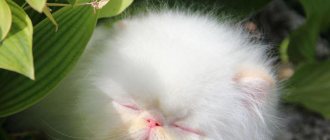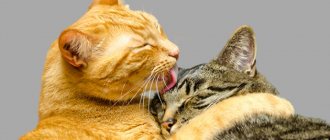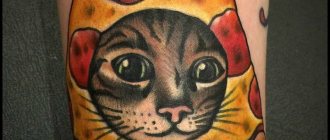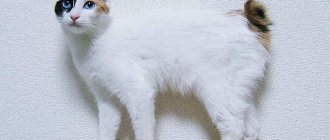In Brazil there are large cats - puma and jaguar, weighing up to 100 kg. and up to 2 meters long.
There are smaller cats - the ocelot and as many as 2 types of wild forest cats: straw and forest tiger. Actually, the ocelot is also a wild Brazilian cat, known since 1758. It is famous for the fact that at one time it was barbarically exterminated because of its unique skin. Now, thank God, hunting him is prohibited. Only poachers remain, but now the hunt is for them, and not for the Jaguatirica - that’s what the Brazilians call their spotted wild cat, which climbs branches no worse, and in some cases even better than a monkey.
But now we will not talk about all cats in Brazil, but only about the breed, which is called the Brazilian Shorthair cat.
Where to buy a Brazilian cat
This breed is not yet very common in the CIS countries. What can I say, Brazilians are generally rare, where they are common. Therefore, if you want to have just such a cat, you should go to Brazil for it. Of course, sometimes you can buy such a cat in your own country, but no one can guarantee that this is not some kind of translation, but a real representative of the breed.
Unfortunately, in the vastness of Russian-speaking countries there is not yet a single nursery where you can buy a Brazilian shorthair cat. Buying a kitten is quite difficult, but there are no barriers for those who want it. There is an option that some breeders who breed a certain breed provide kitten delivery services from abroad.
Shorthaired Brazilians are a rather beautiful breed that has already captivated many with its charm and simplicity. Such a cat deserves decent treatment, for which she repays people with her affection, devotion and love.
American shorthair cat
Breed Features
If we sort out some of the features of the Brazilian cat, we get the following:
- Character – playful
- Attitude – positive
- Intelligence – developed
- Behavior is formed throughout life
- Bad habits - tries to taste any unfamiliar object (needs regular deworming).
In addition, a long street life has left a certain imprint on the cat’s behavior in the house: the “Brazilian” is not only an omnivore, she loves to eat herring under her fur coat, cutlets under the sofa, fish under the pillow on the bed, that is, she is not only a “thief”, but also and "hiding place". Having stolen a piece she likes, she hurries to hide it more securely “for a rainy day” so that she can enjoy “homemade preparations” in a calm atmosphere afterwards.
Attitude towards other animals – even, but without much affection
The requirements for the exterior of these kitties are banal:
Good physical condition, corresponds to weight and constitution, well-groomed. The eye color should be in harmony with the coat color. Any color is allowed except Siamese acromelanic. The deeper the even color, the better, and if the cat “wears” a pattern on its skin, then a bright and harmoniously combined tabby is pure beauty.
And, of course, balanced behavior is very important.
History of origin
For a long time, this breed developed completely independently, without any human intervention. Just a few decades ago, aboriginal cats inhabited the streets of Brazil and seemed, at first glance, to be the most common.
But in the early eighties of the last century, experts became interested in these animals and conducted investigations that showed that this population of cats is significantly different from all known breeds.
Brazilian breeders decided to create a national cat breed, and a breeding program was soon created. In 1994, breed standards were determined, after which it received official recognition.
Origin of the breed
The history of these animals began a long time ago. Their ancestors grew up in the wild and quietly took root in their new homeland. At one time, various goods were imported to Brazil, which was more isolated than Europe, promising considerable income, and cats, as the only possible protection against rodents, became a valuable cargo. They noticed the mustachios only in the 80s of the last century, and started breeding them. At first, the Brazilian cat was combined into the Celtic class, which also included the European cat. She then pre-registered. And finally, in 1999, the International Cat Federation (FIFE) recognized the Brazilian cat as a separate breed.
Standardization of the Brazilian cat
Brazilian engineer Samuel Paulo Ruschi, who lived with an ordinary street cat who was lucky enough to participate in the improvement of European cats, came up with the idea of creating the first Cat Lovers Club in Brazil in Rio de Janeiro and, accordingly, presenting a national breed to the WCF for consideration.
His proposal was treated favorably, and in 1980 the Brazilian Cat Fanciers Federation (BCF) was registered. All that was left to do was to “standardize” the national breed.
Features of the standard
The Brazilian cat is endowed with a dense, strong body, with a wide, slightly rounded chest. Despite her size, she is slender and graceful.
The legs are strong, long, proportional to the body. The head is small, with soft outlines, slightly elongated, smoothly transitioning into a strong, muscular neck.
A strong chin protrudes slightly forward. The triangular-shaped ears are set wide apart and rounded at the ends. Some animals have small tassels on them.
The slightly slanted eyes of Brazilian cats stand out with their almond shape and are surprisingly beautiful and expressive. They can be any color, but they always harmonize with the color of the fur coat.
The Brazilian coat is short, close to the body, quite soft and silky, shiny and tends to shimmer in the sun.
Breed standards do not provide for any color restrictions. Brazilian cats come in a wide variety of colors.
Cat food
This breed is not particularly demanding when it comes to food; it can easily get used to industrial food and then switch to natural food. Cats will happily eat a variety of raw vegetables and grass.
However, veterinarians do not recommend mixing both types of food. And if the choice is made towards natural food, it is better to get advice from a specialist. If the pet owner prefers natural food, you should select foods rich in vitamins and minerals.
As natural food, you can resort to such products as cottage cheese, lean meats (chicken, turkey), lean fish, cereals, soups. Among cereals, preference can be given to oatmeal, buckwheat and semolina.
You need to pay special attention to the choice of dry food. You should not use domestic food. The best varieties of dry food include elite brands from France and the USA (Roal Kanin K 34, Hills). They contain high-quality filler, various microelements and vitamins.
Contraindicated foods include the following foods: fatty fish and meat, various smoked foods, marinades, salt, tubular bones (poultry). In general, you should treat your pet with bones carefully: hollow bones can injure your pet’s esophagus and intestines when chewed. Cartilage is safer.
Frequent feeding on carrots and seafood can affect coat color. It has been noticed that if a cat frequently eats liver, the coat becomes darker.
Acquisition
Unfortunately, it is very difficult to buy this cat in the territory of the former Soviet Union. In our countries, this breed is still not popular, and it is almost impossible to find information about the owners of these cats and nurseries. But occasionally you can find advertisements on the Internet where kittens of these cats are sold at a price of 350-500 dollars.
Brazilians have excellent health
Character and behavior
Representatives of this breed are distinguished by a true cat character. They are very affectionate and sociable, and behave calmly in noisy companies.
At the same time, they have a certain amount of independence and self-esteem. Brazilians are unusually social animals that quickly become attached to their owners and greatly appreciate their affection.
In the absence of support from people or neglect, cats can become irritable and even aggressive.
These are very sociable and trusting animals who are always happy to have guests and strive to be the center of attention. Cats cannot easily endure long separation from their owners, but for busy people who spend most of their time at work, this breed is quite suitable.
The cat will find something to do during the day and will patiently wait for the return of its household members.
Brazilians are a breed that was shaped by the street. Therefore, they are particularly energetic and mobile. They love to walk in the fresh air and happily participate in outdoor games.
Representatives of this breed have a very highly developed hunting instinct. If a Brazilian cat lives in the house, the absence of mice is guaranteed. Gets along well with other pets, establishing quite friendly relationships with them.
The owners of these pets note their high level of intelligence and quick intelligence. These cats are easy to train and raising them so that they learn certain rules of behavior is not difficult.
Character of the breed
It is difficult for a non-specialist to distinguish a purebred Brazilian cat from an ordinary domestic purr. Photo.
Small in size, affectionate and patient, sociable but unobtrusive, this cat will quietly win your heart. And, once in your house, having carefully examined everything, she will quickly become a full-fledged mistress of it. “Earning money” will be honest: for starters, it will completely rid your house of mice and rats (if any are found), endure the squeezing of your children, sing songs next to your chair by the fire, entertain your family with simple games with a bow.
In the event of an unjustified insult, she will turn to you such a piercing gaze from her almond-shaped eyes that you will immediately understand how unfairly she was treated. Conscience will torture you!
And you will rush to stroke your kitty’s soft, short fur, devoid of any “insulation” - undercoat. By the way, the “Brazilian” will not have ragged, hard or plush fur - only smooth and silky.
The cat carefully tidies up its fur on its own; difficulties can arise only during shedding - a neat “Brazilian” can swallow dead hairs and give them to you at the door or in the middle of the room in a very unsightly state.
The difficulty may also lie in the cat’s disobedience.
Having grown up on the streets of Rio de Janeiro, the Brazilian Shorthair is distinguished by its special love of freedom: it perfectly follows the commands of one of the family members, but can flatly refuse to carry them out at the request of another. An attempt to “put pressure” on the animal will cause a “deaf defense”, which can result in deep scratches and bites. “Love has the manners of a wild bird; it does not live in captivity...”
Remember that the character of the Brazilian cat was formed in the breed over many centuries of gypsy wanderings.
She will not fall into a depressed state during your absence, she will patiently wait for familiar steps, but when you extend your hand, after a long absence, be prepared to get what you deserve. Once. In a minute you will no longer find a creature more affectionate and loving than this long-eared fury.
Choosing a kitten
You can only buy a kitten in Brazil, since it is almost impossible to meet purebred representatives outside the country. Brazilian kittens, reminiscent of outbred animals, are sold exclusively in Brazil, since there is little interest in the breed outside the homeland, and breeders are not eager to share their national treasure. Outside the country it is almost impossible to meet them. If you come across an advertisement for the sale of a Brazilian shorthair kitten, you should be afraid that, hiding behind a beautiful name, dishonest sellers will sell an ordinary yard baby. There are special nurseries only in the animal’s homeland. If you can’t visit Brazil, you can look for Brazilian babies at international cat shows, where purebred pets appear on sale from time to time. The cost of such a kitten is 300-600 dollars.
How to choose a kitten
It is difficult to distinguish a Brazilian kitten from its outbred relative. To avoid being a victim of a scammer, you need to ask the seller for a pedigree and a veterinary passport with vaccinations included. The buyer should look at the mother cat to make sure she is in healthy and adequate condition.
Healthy Brazilian kitten:
- meets breed standards;
- moderately well-fed;
- active, inquisitive, playful;
- eats with appetite;
- does not show fear or aggression;
- with clean eyes, ears, anus;
- without traces of skin diseases and parasitic lesions.
Cost and nurseries
It is useless to look for nurseries in Russia, the CIS, and Western Europe. Native shorthair cats are sold only by Brazilian breeders.
The Brazilian shorthair breed is relatively inexpensive; the price of a kitten in the pet (companion) category is $150-200 . But overseas paperwork and transportation are expensive. The total cost exceeds $1000.
Feeding and care
The Brazilian cat breed is completely unpretentious and does not require any special care. But this does not mean that its maintenance can be done without standard hygiene procedures. Once a week, it is recommended to wipe your pet's ears and eyes from dirt.
For this purpose, it is best to use a napkin soaked in a solution of boric acid or tea leaves. Occasionally it is recommended to brush the animal's teeth.
Due to its short fur, the cat does not need frequent brushing, however, during the molting period this procedure must be done quite often. Regular combs are not suitable for such fur and can damage the delicate skin of the animal, so experts advise using a rubber brush.
A cat's frequent licking of its shedding coat can cause hairballs to form in its stomach. The owner should stock up on a special preventive paste that prevents this phenomenon, or feed the pet grass and food that promotes fur removal.
The Brazilian Shorthair cat, as a rule, does not have any preferences regarding diet. If it consists of natural products, then it must include meat in any form, fermented milk products and vitamin supplements.
Fish and animal liver should be excluded, as they often cause infection with worms. You should also not give chicken skins and vegetables containing a lot of starch - they take too long to digest in the cat's stomach.
When using dry food for feeding, you need to choose only high-quality premium brands.
Catering
The Brazilian cat is not picky about food, so it will eat everything you offer. However, remember: you should never feed an animal from your table! Soups, many cereals, fried, salty, fatty, spicy foods will cause serious harm to health.
There are a number of rules:
- There should be two bowls: for water and for food. If you feed your animal natural food, the leftovers should be removed as soon as the cat eats, without allowing them to sour. Dry food can last longer.
- Clean water at a comfortable temperature (not cold or hot) should be freely available to the animal at all times. You cannot pour it from the tap! Use any household filter to clean it or leave it in an open container for 10-12 hours (during this time, harmful compounds will evaporate). You can also buy bottled water.
- Cats older than six months are fed 2 times a day: morning and evening. From 4 to 6 months - 3-4 times, babies - 5-6.
Natural products
Allowed to give:
- Lean meat (chicken, rabbit, veal, beef, lamb). The meat is pre-frozen in the freezer, and before feeding, the piece is doused with boiling water and cut into convenient (but not small) pieces.
- Offal (liver, hearts, stomachs, chicken necks) - they are stewed, boiled or served raw.
- Sea fish (hake, trout, salmon, flounder). The fish must be boiled and cleaned of bones. Do not feed your cat fish more than once a week: excess leads to kidney problems and the development of urolithiasis.
- Porridge (buckwheat, oatmeal, rice, millet). Porridge is fed every other day, adding a teaspoon of vegetable oil, chopped boiled chicken protein, vegetables (pumpkin, carrots, beets, zucchini, green beans, greens).
- Dairy products: cottage cheese, yogurt, sour cream, fermented baked milk, Varenets. Be careful with whole cow's milk: if the cat develops diarrhea, it should be removed from the diet.
It is prohibited to give:
- Fatty meat, bones, lard, skin;
- River fish;
- Sweet, smoked, salty, dried, canned;
- Sausage, frankfurters;
- Legumes, avocado, potatoes, onions, garlic;
- Juice, tea, coffee, mineral and sparkling water;
- Chicken yolk;
- Dog food;
- Human vitamins.
Recommended food
If you prefer ready-made food, keep in mind: you cannot take the first food you come across from the store shelf, and even more so, trust advertising slogans. Read the composition!
Good quality food contains ingredients, and high-quality products are used: fresh and dehydrated meat, fish fillets, natural preservatives (mixtures of tocopherols, for example), fruits and berries, rice, lentils, sweet potatoes, a complex of vitamins and minerals. Only from such food will your cat receive all the necessary substances, look good and feel great.
The holistic and super-premium food groups have proven themselves well. Holistic: Acana, Farmina N&D, Wellness CORE. Super-premium: Josera, Karmy, Landor.
Economy and premium food: Darling, Felix, Perfect Fit, Whiskas.
Below are the recommended holistic and super-premium foods. Links with the names of the food are clickable, on them you can, within our website, get acquainted with the descriptions of the food and read reviews from owners of Brazilian shorthair cats.
| Holistic | Holistic | Super premium |
| AATU | Gina Elite | Leonardo |
Consider the age and condition of your pet. Kittens need to be given more nutritious food, but castrated and sterilized animals change their hormonal levels, protein metabolism and the functioning of the genitourinary system, they begin to eat more - therefore, they need to buy completely different food.
How to maintain and care
It is necessary to comb the cat every week to remove dead hairs from its fur that could not be accidentally eaten. And, by the way, even if the cat is constantly brushed, she still needs help removing hairballs from her stomach. Not only all clean specimens face this problem. The fact is that over time, wool accumulates in the animal’s stomach. To breed it, specially designed types of feed or special herbs are used.
If the cat is clean, then it takes care of itself. But sometimes it is still worth checking the cleanliness of the ears, as well as the eyes. And it is better to accustom an animal to hygiene procedures from childhood.
Advantages of the breed
The Brazilian is a great friend for the whole family. The animal is distinguished by devotion and fidelity. The pet gets along well in any family. The cat gets along well with children. They don't bite or scratch while playing.
Brazilians are excellent hunters. Cats are fast, dexterous, strong, resilient. They know how to catch mice and hunt other rodents.
Cats are easy to care for. They do not have long fluffy fur. It is enough to bathe your pet 2-3 times a year, comb it once a week and clean its eyes and ears as it gets dirty.
Health
The breed, formed in its natural environment, has excellent immunity and is not predisposed to genetic diseases. Like other pets, the Brazilian cat needs annual vaccinations.
In addition, once a quarter it is necessary to give her anthelmintic drugs, preferably in tablet form - veterinarians believe that this is the safest.
With proper balanced nutrition, appropriate care and preventive measures, health problems are practically eliminated, and the animal can live a long and happy life, the average duration of which for this breed is 15–20 years.
Reproduction
Reproduction of the Brazilian cat
At the age of 1 year, Brazilian females begin their reproductive period. The average duration of pregnancy is 62-68 days. In cats of this breed, childbirth occurs without complications. Kittens are born within 1 hour. The mother independently chews the umbilical cord and licks the babies.
On average, the peak of sexual activity for outdoor cats occurs in the spring. In the Brazilian breed, the desire for sexual activity may occur in the spring. During estrus, females can become aggressive. And cats during sexual activity begin to mark their territory with a pungent odor.
Kittens can be born throughout the year. Babies are born blind and deaf. They begin to see only after 15-20 days. In the third week, cats can be fed boiled meat and vegetables.
What to feed your Brazilian Shorthair?
If you choose between a large number of feeds, then you should give your preference to premium food. Such cats are not at all picky, and even if you offer them simpler food, they will not refuse it. But is it worth it, because the health of your pet is much more important.
You can also feed your cat natural food, which includes meat along with dairy products. It is better to exclude any fresh fish from the diet, because through it you can become infected with worms.
It is worth taking care of your pet and not feeding it chicken skin or starchy vegetables, because, as experienced breeders note, not all cats have a digestive system in good condition. It is also not permissible to give red vegetables to animals of this breed. The cat's gastrointestinal tract is not able to digest such food.
laperm - description of the breed and character of the cat
Health and nutrition
Brazilian women have good health and immunity to many diseases thanks to natural selection. In the past, cats had to survive in difficult conditions, resulting in only the strongest surviving. Diseases transmitted by inheritance are not typical for them. However, cats often have problems with the gastrointestinal tract and skin. The breed is susceptible to infection by 82 worms, 32 of which can be transmitted to humans. Once every 3 months the pet is given deworming tablets.
As a preventative measure, vaccines have been developed against 7 diseases:
- Chlamydia
- Calcivirosis
- Rabies
- Lichen
- Rhinotracheitis
- Infectious peritonitis
- Panleukopenia
Vaccination is done once a year. Often 2 injections are given at once.
To avoid problems with the gastrointestinal tract, you should focus on lean meat and dairy products in your diet. It is worth choosing the type of food: dry food or natural food. Doctors do not recommend combining. Dry food is a balanced diet for a cat that does not require additional additives. It is advisable to buy premium and super-premium food. They do not contain preservatives, carcinogens, dyes or flavors. Dry food is a dehydrated food, so it is important to maintain water balance.
Brazilian cat nutrition
If you feed your cat natural food, choose low-fat products. The diet may include lean meat, dairy products, vegetables, cereals, and soup. Do not feed your cat food from the table or human sweets.
It is worth excluding fried, spicy and sweet foods. It contains a lot of fat, which can lead to obesity. To avoid problems with the digestive tract, you need to study feeding standards. An adult cat is fed 1-2 times a day.
During shedding, cats lose more hair than usual. Seasonal molting occurs twice a year: in autumn and spring. When washing, animals swallow their hair, which makes it difficult for the digestive system to function. During such periods, you need to introduce a special paste into the diet, which can be bought at a pet store.
Appearance
Description of the Brazilian Shorthair breed has common points with the European cat. The appearance of the “Brazilians” is unobtrusive, and may seem ordinary to some; however, with proper care, the pets look very impressive. The Brazilian cat breed has its own “calling card” - a piercing, understanding and intelligent look, which is noticeable even in the photo. In general terms, the “Brazilian” is a strong, well-proportioned, medium-sized animal. The weight of adult pets ranges from 3 to 4 kilograms.
- The head is round, neat, medium in size, wedge-shaped. The width of the head is slightly greater than its height. In young animals, the muzzle looks elongated. The cheekbones are moderately pronounced, the cheeks and whisker pads are well developed. The muzzle is visually shortened, the nose is proportional with a slight bend at the transition to the forehead. The forehead is flat and wide. The chin is neat but strong.
- Ears are medium-sized, rounded, set wide apart. The presence of tassels is not mandatory, but is not discarded either.
- The eyes are expressive, lively, and set close to the bridge of the nose. The shape varies from round to almond-shaped.
- The body is proportional, strong, classic, rectangular shape. The chest is well developed and has a rounded shape. The neck is medium, mobile, smoothly turning into the back of the head. In adult animals, especially males, there are decorative folds of skin on the neck.
- The legs are equal in length to the height of the body, the muscles are medium. The brush is small, oval, collected, the claws are well developed.
- The tail is proportional, mobile, rounded at the end.
Description of the exotic cat breed
The peculiarity of this breed is simplicity. At first glance, these cats are unremarkable and can easily be confused with yard cats. They do not at all correspond to the Brazilian love for the bright and shiny, but they leave an indelible impression on everyone who met the intelligent look of the Brazilian beauty. Although it is difficult to give a specific description of the breed, FIFe has specified strict standards for Brazilian cats:
The Brazilian cat breed, at first glance, resembles simple yard animals.
- The head is small or medium-sized, elongated, slightly longer than wide.
- The nose is not short, without a stop.
- The chin is strong, slightly protruding.
- The ears are soft, large, with rounded ends and possible tassels, set high.
- The eyes are large, almond-shaped or round, the color of the iris is in harmony with the color.
- The body is elegant, but well muscled, with a strong neck and medium limbs.
- Any color is allowed, except shades of chocolate and blue.











